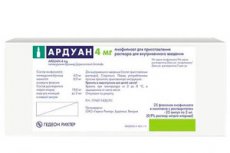新出版物
阿杜安
阿列克谢·克里文科,医学审稿人
最近審查:04.07.2025
最近審查:04.07.2025

Arduan(哌库溴铵)是一种非去极化肌肉松弛剂。这类药物用于暂时放松骨骼肌,这在各种医疗程序(包括外科手术和插管)中是必需的。
哌库溴铵通过阻断神经肌肉传递发挥作用。它与肌肉细胞突触后膜上的烟碱乙酰胆碱受体结合,阻止乙酰胆碱结合,从而阻止肌纤维去极化。这会导致肌肉松弛。
適應症 阿杜阿纳
- 在手术干预期间提供肌肉放松。
- 在重症监护中,为无法自行呼吸的患者提供机械通气。
- 以利于气管插管。
發布表單
- 安瓿:含有一定量的液体活性物质,用于静脉注射。
- 小瓶:可能含有需要在使用前用合适的溶剂稀释的溶液。
藥效學
哌库溴铵(Arduan)是一种非去极化肌肉松弛剂,用于在手术或重症监护期间放松骨骼肌。哌库溴铵的主要作用机制是阻断神经肌肉传递,这是通过与骨骼肌中烟碱受体上的乙酰胆碱竞争性拮抗来实现的。
作用机制:
- 乙酰胆碱受体阻滞剂:哌库溴铵与神经肌肉接头突触后膜上的烟碱乙酰胆碱受体结合,从而阻止乙酰胆碱的作用。这导致膜去极化和随后的肌肉收缩受到阻止。
- 竞争性拮抗作用:哌库溴铵是乙酰胆碱的竞争性拮抗剂,这意味着它与乙酰胆碱竞争与受体结合。这种阻断作用可以通过增加乙酰胆碱的浓度来克服。
效果:
- 肌肉放松:哌库溴铵可使骨骼肌放松,因此可用于外科手术和重症监护。
- 无去极化:与去极化肌肉松弛剂不同,哌库溴铵在放松之前不会引起肌肉收缩的初始阶段,从而降低了手术后肌肉疼痛的风险。
起效时间及持续时间:
- 起效时间:静脉注射后数分钟内哌库溴铵开始起效。
- 作用持续时间:作用持续时间可能因剂量而异,但通常为60-90分钟。肾功能或肝功能受损患者的作用持续时间可能会延长。
藥代動力學
引入和吸收:
- 给药途径: 哌库溴铵通过静脉给药。
- 吸收:静脉注射后,药物立即进入全身血液,迅速发挥药效。
分配:
- 分布容积:哌库溴铵的分布容积较小,表明其组织渗透有限。其主要作用于神经肌肉接头处。
- 蛋白质结合:该药物与血浆蛋白有中度结合。
代谢:
- 主要代谢器官: 哌库溴铵在肝脏中代谢。
- 代谢物:产生的代谢物通常无活性,但对于肝功能受损的患者,它们对药物作用持续时间的影响可能很大。
提款:
- 排泄途径:该药物及其代谢物主要通过肾脏排泄。
- 消除半衰期:哌库溴铵在健康成人中的消除半衰期约为1.5-2小时,但在肾功能不全时可能会延长。
不同患者群体的特点:
- 老年患者:老年患者可能会出现药物半衰期延长和药物清除率降低,需要调整剂量。
- 肾功能不全患者:此类患者的药物消除速度较慢,需要仔细监测并可能需要调整剂量。
- 肝功能不全的患者:肝功能不全的患者也可能会经历药物半衰期延长和药物代谢改变。
药代动力学参数:
- 起效时间:静脉注射后2-3分钟药物开始起效。
- 作用时间:取决于药物的剂量和清除率,通常为60-90分钟。
- 蓄积:反复服用该药可能会产生蓄积,尤其是对于肾功能或肝功能受损的患者。
劑量和管理
建议剂量:
初始剂量给药:
- 成人的起始剂量通常为0.06-0.08毫克/公斤体重。
- 对于1岁以上的儿童,初始剂量为0.05-0.07mg/kg体重。
维持剂量:
- 为了保持肌肉放松,可能需要额外服用 0.01-0.02 mg/kg 体重,并根据临床情况酌情服用。
作用持续时间:
- 初始剂量的作用持续时间通常为60-90分钟。
- 维持剂量的作用时间取决于个体患者的反应。
给药方法:
注射:
- 该药物通过缓慢静脉注射给药。快速给药可能会导致不良副作用。
状态控制:
- 在给药期间和给药后,需要不断监测呼吸功能、心血管系统和肌肉放松水平。
特别说明:
肝肾功能受损患者:
- 对于此类患者,可能需要调整剂量并进行更密切的监测,因为药物代谢和消除可能会受损。
老年患者:
- 应考虑到肝肾功能可能下降的情况来调整剂量。
与其他药物合用:
- 与其他肌肉松弛剂或麻醉剂联合使用时,应调整Arduan的剂量,以避免过度肌肉松弛。
在懷孕期間使用 阿杜阿纳
妊娠安全类别:
- 哌库溴铵对孕妇的安全性数据有限。该药物在美国通常被FDA列为C类药物,这意味着动物研究表明其对胎儿存在不良影响,但目前尚无充分且良好对照的人体研究。
风险和建议:
- 妊娠期:仅当对母亲的潜在益处大于对胎儿的潜在风险时,才应在妊娠期间使用哌库溴铵。医生应根据患者病情仔细评估后做出此决定。
- 剖腹产麻醉:哌库溴铵可用于剖腹产手术的肌肉松弛,但必须考虑其对新生儿的潜在风险,例如呼吸抑制。在这种情况下,建议使用新生儿复苏设备和经验丰富的人员。
- 哺乳期:尚无关于哌库溴铵经乳汁排泄的数据。因此,建议在治疗期间避免哺乳,或决定在用药期间停止哺乳。
禁忌
- 对药物成分过敏:如果已知对哌库溴铵或药物的任何其他成分过敏或过敏,则禁用。
- 重症肌无力:由于哌库溴铵是一种肌肉松弛剂,因此重症肌无力患者禁用,因为它可能会加重肌肉无力。
- 严重电解质失衡:如果存在严重电解质失衡,如低钾血症(低钾)或高钙血症(高钙),则禁用哌库溴铵,因为这可能会增加或减少肌肉松弛作用并导致对药物的不可预测的反应。
- 严重肝肾功能不全:由于哌库溴铵在肝脏中代谢,经肾脏排泄,因此严重肝肾功能不全患者禁用,有蓄积危险,且有增加毒性。
- 急性神经系统疾病:禁用于患有急性神经系统疾病(如脊髓灰质炎)或严重脑和脊髓创伤的患者。
副作用 阿杜阿纳
- 过敏反应:在极少数情况下,可能会发生过敏性休克等严重过敏反应,需要立即就医。
- 肌肉无力:药物停止作用后,可能会出现长时间的肌肉无力,尤其是患有潜在肌肉疾病的患者。
- 低血压和心动过缓:哌库溴铵可能导致低血压(低血压)和心率减慢(心动过缓)。
- 唾液分泌过多:有些患者可能会出现唾液分泌增多的情况。
- 呼吸问题:在极少数情况下,由于残留的肌肉无力,可能会出现呼吸困难。
- 局部反应:注射部位可能会出现局部反应,如疼痛或炎症。
- 长期麻痹:一些患者可能会经历药物的长期影响,特别是如果他们的肾功能或肝功能受损。
- 电解质失衡:使用哌库溴铵可能会导致血液中电解质水平的变化,需要监测和纠正。
- 长期肌肉无力:在极少数情况下,手术后可能会出现长期肌肉无力,这可能需要额外的呼吸支持和监测。
- 心动过速:在某些情况下,可能会出现心跳加快。
過量
- 深度、长时间的肌肉放松:骨骼肌过度放松,可使呼吸困难,造成呼吸衰竭。
- 心动过缓:心率缓慢。
- 低血压:血压下降。
- 虚弱:极度虚弱和疲劳。
注意!
為了簡化對信息的理解,本指令使用了藥物 "阿杜安",並根據藥物的醫療用途官方說明。 使用前請閱讀直接用於藥物的註釋。
描述僅供參考,不適用於自我修復指導。 這種藥物的需求,治療方案的目的,藥物的方法和劑量僅由主治醫師確定。 自我藥療對你的健康有危害。

